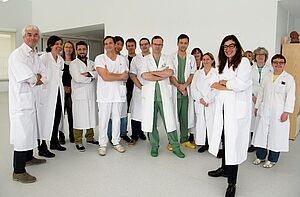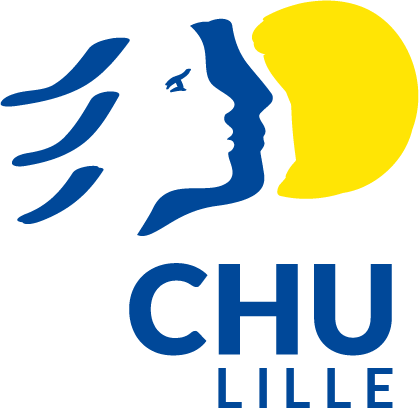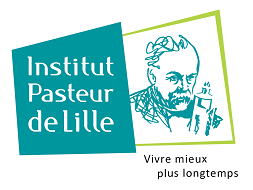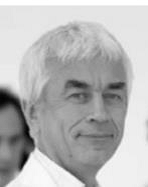Topic 2: Cardiac pathologies, blood flow abnormalities and hemostasis
Theme 2: Cardiac pathologies, blood flow abnormalities and hemostasis
Led by Sophie Susen and Eric Van Belle
The objective of Team 2 is to better understand the pathophysiological processes involved in aortic valve disease and complication and to identify innovative drug targets.
To achieve our goal, we have assembled a multidisciplinary team that includes on the one hand hematologists, specialists in hemostasis, thrombotic and hemorrhagic disorders, vascular and circulating cells (leukocytes, platelets) and on the other hand cardiologists and cardiac surgeons, specialists in valvulopathy, cardiology and implantation of cardiac devices (transaortic valve replacement, mechanical devices for circulation) The team is led by a specialist in hemostasis, Prof. Sophie Susen, and a specialist in cardiology, Prof. Éric Van Belle.

Sophie SUSEN, MD, PhD, HDR
Eric VAN BELLE, MD, PhD, HDR
Delphine CORSEAUX, PhD, HDR
Annabelle DUPONT, PharmD, PhD, HDR
Francis JUTHIER, MD, PhD, HDR
Gilles LEMESLE, MD, PhD, HDR
Antoine RAUCH, MD, PhD
Emmanuel ROBIN, MD, PhD, HDR
Madjid TAGZIRT, PhD
André VINCENTELLI, MD, PhD, HDR
Christophe ZAWADZKI, PharmD, PhD

Sophie Susen, MD, PhD
Contact info:
Service Hémostase-Transfusion
Institut Cardio-Pulmonaire
Centre Hospitalier Universitaire de Lille
Bd du Pr Jules Leclercq
59037 Lille Cedex, France
tel +33 320 445 937
Fax +33 320 446 989
Email: sophie.suseninserm.fr
Professor Sophie Susen is a hematologist and professor of medicine at the Lille Medical School. In addition to co-leading Team 2, she is the director of the Haemostasis and Transfusion Service of the Lille University Hospital and the national coordinator of the Willebrand Disease Reference Centre. Her research interests are focused on the impact of blood flow on hemostasis. She is at the origin of the description of the Willebrand Factor as a marker of blood flow which led to two publications in the New England Journal of Medicine.
Sophie Susen is the coordinating investigator of the PHAM clinical trial (Prevention of Hemorrhage After implantation of an Mechanical circulatory support - NCT02488525) selected in the 2014 PHRC campaign. This trial led to a patent for which she is the principal author (FR1552982). She coordinated the submission of the RHU- WillAssistHeart dossier ranked 1st by the jury in 2017.
She is also a member of the think-tank "Perioperative Hemostasis Interest Group" and has participated in the writing of numerous national recommendations in hemostasis and transfusion. She is a member of the board of the "French Hemostasis Group". She is frequently invited to join scientific expertise groups for manufacturers of drugs acting on hemostasis.
Eric Van Belle, MD, PhD, FESC, FACC
Contact info:
Institut Cardio-Pulmonaire
Centre Hospitalier Universitaire de Lille
Bd du Pr Jules Leclercq
59037 Lille Cedex, France
tel +33 320 445 937
Fax +33 320 446 989
Email: eric.vanbelleuniv-lille.fr
Professor Eric Van Belle is an interventional cardiologist and professor of medicine at the Lille Medical School, a "Fellow" of the European (FESC) and American (FACC) Societies of Cardiology, and winner of the Alain Castaigne Prize of the French Society of Cardiology in 2017. In addition to co-leading Team 2, he directs the Heart-Lung Institute and the Interventional Cardiology Department at the Lille University Hospital. His frequently cited work (H index = 45) and publications in the field of transcatheter aortic valve implantation (TAVI) have improved understanding of this procedure. He has provided insight into the impact of using invasive functional assessment methods for coronary stenosis (Van Belle E et al. Circulation 2014; Van Belle E et al. JACC Cardiovasc Interv 2018).
Eric Van Belle is principal investigator of the multicenter randomized clinical trial "WITAVI-REAL", winner of the 2017 Hospital Clinical Research Program that will evaluate the impact of the use of a rapid biological test for willebrand factor on minimally invasive TAVI procedures. Finally, he is co-inventor of a new indication for willebrand factor in the prevention of bleeding after circulatory assistance implantation (FR1552982. 2015/04/07. France).
Fibrocalcific stenosis of the tricuspid aortic valve (TAS), i.e. narrowing of the aortic valve opening (VA), affects the elderly population and its prevalence is expected to double in the next 50 years. This major public health issue is associated with a high morbidity and mortality. Without treatment, patient survival is limited (2-3 years) after the onset of symptoms. Today, its pathogenesis remains poorly understood, which leads to the absence of effective pharmacological intervention strategies. The only treatments are valve replacement, either by transcatheter aortic valve implantation (TAVI) or by surgical replacement (AVR). Recently, the use of bioprosthesis (BPV) (versus mechanical valves) for the treatment of AVS with TAVI has increased significantly. Recent studies have reported similarities between the histological findings of stenotic VA and degenerated BPV, such as the presence of lipids, inflammation, and calcifications. To date, no targeted medical therapy has been proven to prevent, slow, or treat fibrocalcific VAS or prevent degeneration of BPV.
Sudden changes in blood flow probably influence the biology of blood cells, their activation and their interaction with proteins involved in hemostasis, such as von Willebrand factor (VWF). However, the consequences of flow changes associated with the loss of pulsatility are poorly described. The interaction of platelets with circulating leukocytes, particularly neutrophils and monocytes, in innate defense against pathogens and, conversely, the pleiotropic role of leukocytes in hemostasis, collectively referred to as "immunothrombosis," have been described recently. A direct link to the coagulation system is illustrated by the induction of a pro-coagulant phenotype, both in monocytes, through membrane expression of tissue factor, which triggers the factor VII-dependent coagulation pathway, and in neutrophils, through the release of extracellular neutrophil traps (NETs), which trigger the factor XII-dependent pathway. We will determine whether flow changes modulate the function of blood cells involved in hemostasis. We will use in vitro models developed in our laboratory and in collaboration and study the consequences of alterations in blood flow in patients. Changes from pulsatile to continuous flow will be studied in patients receiving mechanical circulatory support, either extracorporeal membrane oxygenation (ECMO) (WiTECMO-H study part of the WillAssistHeart project) or LVAD (as part of the PHAM trial) and changes from continuous to pulsatile flow in TAVI patients (Methystroke study). We have developed biological collections. We have also developed a collection of clots from different sources: stroke, myocardial infarction and ECMO circuits.
Our team studies the main pathways involved in the development of cardiac valve calcification and in the alteration of blood flow and their consequences on hemostasis and the risk of bleeding or thrombosis.
The team's activity can be divided into two main research programs:
To study the potential of different pathways to slow VAS and bioprosthetic degeneration
To study the consequences on hemostasis of flow disturbances due to cardiac structural abnormalities and to qualify von Willebrand factor (VWF) as a biological marker of blood flow.
Research Project 1:
Fibrocalcific stenosis of the tricuspid aortic valve (TAS), i.e. narrowing of the aortic valve opening (VA), affects the elderly population and its prevalence is expected to double in the next 50 years. This major public health issue is associated with a high morbidity and mortality. Without treatment, patient survival is limited (2-3 years) after the onset of symptoms. Today, its pathogenesis remains poorly understood, which leads to the absence of effective pharmacological intervention strategies. The only treatments are valve replacement, either by transcatheter aortic valve implantation (TAVI) or by surgical replacement (AVR). Recently, the use of bioprosthesis (BPV) (versus mechanical valves) for the treatment of AVS with TAVI has increased significantly. Recent studies have reported similarities between the histological findings of stenotic VA and degenerated BPV, such as the presence of lipids, inflammation, and calcifications. To date, no targeted medical therapy has been proven to prevent, slow, or treat fibrocalcific AVS or prevent BPV degeneration.
The aortic valve has a leaflet structure consisting of valvular endothelial cells (VECs), at the blood-contacting surface, as well as interstitial cells (ICVs) and an extracellular matrix (ECM). ICVs are a major component of the VA and effectors of valve fibrocalcification through ICV/ECV interaction. A better understanding of ICV biology may provide therapeutic targets by targeting the slowing or stopping of fibrocalcification progression. We focus on the calcification process, to highlight new factors modulating these processes and to identify, in different pathways, innovative pharmacological targets that will be validated by a combination of studies on human samples in vitro and in vivo of preclinical approaches (animal models of AV calcification and bioprosthetic degeneration)
In addition, we have set up a biobank of human tissues and cells. Our results have a novel potential to reduce calcification of native valves or bioprosthesis. A patent is pending (Inserm Transfert).
Funding:
The project was supported by a grant from the Fondation de France in 2015 and from the French Federation of Cardiology in 2017. In 2018, we obtained a 430k€ funding from the French National Research Agency (ANR) for the RETINAVs project.
Research Project 2:
Sudden changes in blood flow probably influence the biology of blood cells, their activation and their interaction with proteins involved in hemostasis, such as von Willebrand factor (VWF). However, the consequences of flow changes associated with the loss of pulsatility are poorly described. The interaction of platelets with circulating leukocytes, particularly neutrophils and monocytes, in innate defense against pathogens and, conversely, the pleiotropic role of leukocytes in hemostasis, collectively referred to as "immunothrombosis," have been described recently. A direct link to the coagulation system is illustrated by the induction of a pro-coagulant phenotype, both in monocytes, through membrane expression of tissue factor, which triggers the factor VII-dependent coagulation pathway, and in neutrophils, through the release of extracellular neutrophil traps (NETs), which trigger the factor XII-dependent pathway. We will determine whether flow changes modulate the function of blood cells involved in hemostasis. We will use in vitro models developed in our laboratory and in collaboration and study the consequences of alterations in blood flow in patients. Changes from pulsatile to continuous flow will be studied in patients receiving mechanical circulatory support, either extracorporeal membrane oxygenation (ECMO) (WiTECMO-H study part of the WillAssistHeart project) or LVAD (as part of the PHAM trial) and changes from continuous to pulsatile flow in TAVI patients (Methystroke study). We have developed biological collections. We have also developed a collection of clots from different sources: stroke, myocardial infarction and ECMO circuits.
In high-shear cardiac conditions, bleeding is a major clinical problem with implications for patient management, quality of life, costs, and survival. Other than antithrombotic therapy, little is known about the risk factors for high-shear bleeding, with the exception of VWF, which degrades when exposed to high shear and disrupted flow generated by heart disease or cardiac support. Real-time quantification of VWF cleavage would be a powerful tool to monitor the extent of blood flow disruption under high shear conditions and to predict vulnerability to bleeding. Unfortunately, at present, there are no accurate diagnostic tools to monitor these alterations and early quantitative diagnosis remains difficult. In addition, VWF-containing concentrates have limited efficacy due to the short half-life of VWF. Finally, there is currently no specific treatment for VWF cleavage.
Funding:
In 2014, we were awarded a PHRC-N grant for the PHAM (Prevention of Heamorrhage After Implantation of Mechanical Circulatory Support) trial (€500k).
Ranked #1 (out of 52 projects) for the national application "Hospital-University Health Research" (RHU) and funded €5.6 million in 2017 (WillAssistHeart project; 17-RHUS-0011) to develop diagnostic tools and new treatments against VWF degradation.
2017 PHRC-N grant (€900k) for the WITAVI-Real study, a national multicenter trial to evaluate the impact of VWF measurement by PFA during TAVI.
In 2018, in association with industrial Cpartner orwave, we obtained a PSPC ("programme de soutien aux pôles de compétitivité") of 14 M€ in total from BPI France for the Calypso project (Connected Cardiac Assist LVAD therapy respecting Patient physiology for an optimized care).
Our competences:
- Cell biology: human cells, including valvular interstitial cells (VIC), leukocytes, monocytes/macrophages, platelets.
- Histology: Immunohistochemistry, Microscopy
- Immunophenotyping (flow cytometry)
- Molecular biology: real-time PCR
- Preclinical models: surgery and imaging of large mammals (MRI, echocardiography)
- Clinical studies
Key words:
Von Willebrand factor (VWF); Willebrand disease; hemostasis; hemorrhage; cardiovascular disease; LVAD; aortic valve stenosis; hemodynamics; cardio valvulopathy, blood flow.
Selection of publications:
1. Vincent F, Rauch A, Loobuyck V, Robin E, Nix C, Vincentelli A, Smadja D, Leprince P, Amour J, Lemesle G, Spillemaeker H, Debry N, Latremouille C, Jansen P, Capel A, Moussa M, Rousse N, Schurtz G, Delhaye C, Paris C, Jeanpierre E, Dupont A, Corseaux D, Rosa M, Sottejeau Y, Gomane V, Coisne A, Richardson M, Caron C, Ung A, Carpentier A, Staels B, Lenting P, Van Belle E, Susen S. Arterial pulsatility as a modulator of acquired Von Willebrand Factor defect associated with mechanical circulatory support devices. J Am Coll Cardiol 2018 71(19):2106-2118.
2. Smadja DM, Susen S, Rauch A, Cholley B, Latrémouille C, Duveau D, Zilberstein L, Méléard D, Boughenou MF, Van Belle E, Gaussem P, Capel A, Jansen P, Carpentier A. The Carmat Bioprosthetic Total Artificial Heart Is Associated With Early Hemostatic Recovery and no Acquired von Willebrand Syndrome in Calves. J Cardiothorac Vasc Anesth. 2017 31(5):1595-1602. doi: 10.1053/j.jvca.2017.02.184.
3. Chinetti-Gbaguidi G, Daoudi M, Rosa M, Vinod M, Louvet L, Copin C, Fanchon M, Vanhoutte J, Derudas B, Belloy L, Haulon S, Zawadzki C, Susen S, Massy ZA, Eeckhoute J, Staels B. Human Alternative Macrophages Populate Calcified Areas of Atherosclerotic Lesions and Display Impaired RANKL-Induced Osteoclastic Bone Resorption Activity. Circ Res. 2017 121(1):19-30. doi: 10.1161/CIRCRESAHA.116.310262.
4. Rosa M, Paris C, Sottejeau Y, Corseaux D, Robin E, Tagzirt M, Juthier F, Jashari R, Rauch A, Vincentelli A, Staels B, Van Belle E, Susen S, Dupont A. Leptin induces osteoblast differentiation of human valvular interstitial cells via the Akt and ERK pathways. Acta Diabetol. 2017 54(6):551-560. doi: 10.1007/s00592-017-0980-3.
5. Van Belle E, Rauch A, Vincent F, Robin E, Kibler M, Labreuche J, Jeanpierre E, Levade M, Hurt C, Rousse N, Dally JB, Debry N, Dallongeville J, Vincentelli A, Delhaye C, Auffray JL, Juthier F, Schurtz G, Lemesle G, Caspar T, Morel O, Dumonteil N, Duhamel A, Paris C, Dupont-Prado A, Legendre P, Mouquet F, Marchant B, Hermoire S, Corseaux D, Moussa K, Manchuelle A, Bauchart JJ, Loobuyck V, Caron C, Zawadzki C, Leroy F, Bodart JC, Staels B, Goudemand J, Lenting PJ, Susen S. Von Willebrand Factor Multimers during Transcatheter Aortic-Valve Replacement. N Engl J Med. 2016 375(4):335-44. doi: 10.1056/NEJMoa1505643.
6. Lenting PJ, Denis CV, Susen S, van Belle E. Antibody-Based Protection of von Willebrand Factor Degradation. JACC Heart Fail. 2016 4(6):518. doi: 10.1016/j.jchf.2015.12.018.
7. Rauch A, Caron C, Vincent F, Jeanpierre E, Ternisien C, Boisseau P, Zawadzki C, Fressinaud E, Borel-Derlon A, Hermoire S, Paris C, Lavenu-Bombled C, Veyradier A, Ung A, Vincentelli A, van Belle E, Lenting PJ, Goudemand J, Susen S. A novel ELISA-based diagnosis of acquired von Willebrand disease with increased VWF proteolysis. Thromb Haemost. 2016 115(5):950-9. doi: 10.1160/TH15-08-0638.
8. Susen S, Rauch A, Van Belle E, Vincentelli A, Lenting PJ. Circulatory support devices: fundamental aspects and clinical management of bleeding and thrombosis. J Thromb Haemost. 2015 13(10):1757-67.
9. Roma-Lavisse C, Tagzirt M, Zawadzki C, Lorenzi R, Vincentelli A, Haulon S, Juthier F, Rauch A, Corseaux D, Staels B, Jude B, Van Belle E, Susen S, Chinetti-Gbaguidi G, Dupont A. M1 and M2 macrophage proteolytic and angiogenic profile analysis in atherosclerotic patients reveals a distinctive profile in type 2 diabetes. Diab Vasc Dis Res. 2015 12(4):279-89. doi: 10.1177/1479164115582351.
10. Vincentelli A, Susen S, Le Tourneau T, Six I, Fabre O, Juthier F, Bauters A, Decoene C, Goudemand J, Prat A, Jude B. Acquired von Willebrand syndrome in aortic stenosis. N Engl J Med. 2003 Jul 24;349(4):343-9.
Main collaborations :
- Inserm UMR 1176 (Peter Lenting)
- Inserm UMR_S 1140 (David Smadja)
- Le Centre national de référence pour la maladie de Willebrand
- KU Leuven (Simon de Meyer)
- European Homograft Bank (EHB) à Bruxelles (Ramadan Jashari)
News :
Clinical trial "WITAVI-REAL "A simplified procedure to improve management and long-term patient benefit", Contact Edition number 124
RHU WillAssistHeart : "10 new winners and €74.5 million for the third call for projects
University Hospital Research in Health",
PSPC “CALYPSO”: The CALYPSO research and development (R&D) program, which has a total budget of 25 million euros over 4 years, is financed to the tune of 14 million euros by the Future Investment Program,



